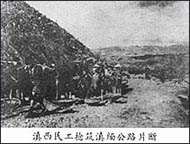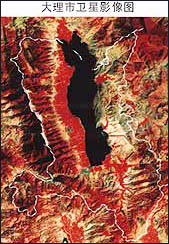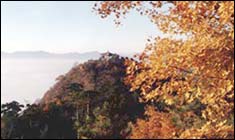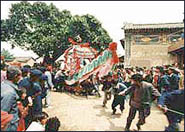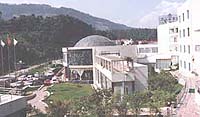History Dali
3,000 years ago, primitive humans inhabited the area of Erhai Lake. As early as the 2nd century B.C., Dali was on the map of the Kingdom of the Central Plains as Yeyu County. In 738, Pilouge, a chieftain of the Bai Tribe, united the six tribes of the Erhai region with the support of the Tang Dynasty, and established the State of Nanzhao, which was destroyed in 902. |
|
Duan Siping, also of the Bai Tribe, established the State of Dali in 938. During the 500-year period of Nanzhao and Dali, Dali City was the political, economic and cultural center of Yunnan Province. Emperor Khublai Khan of the Yuan Dynasty (1271-1368) eliminated the State of Dali, establishing in its place Yunnan Province. The Dali area was renamed Taihe County, and this name persisted during the Ming and Qing dynasties (1368-1911), before it was renamed Dali in 1913. In 1983, Dali County and Xiaguan City merged into Dali City. The city is one of the 24 leading historical and cultural cities and one of the 44 State-designated Scenic Centers in the country.
|
Geography Dali
Located in the western part of Southwest China's Yunnan Province, Dali is located at 25°25'-25°58' north latitude and 99°58'-100°27' east longitude. It is 46.3 kilometers from east to west and 59.3 kilometers from south to north. It covers an area of 1,457.27 square kilometers, of which 229 square kilometers, or 15.71 percent of the total area consists of irrigated territory; 978.927 square kilometers, or 67.27 percent of the total area is mountainous; and 249.343 square kilometers, or 17.02 percent of the total area is occupied by Erhai Lake.The city has Binchuan and Xiangyun to the east, Midu and Weishan to the south, Yangbi to the west and Eryuan to the north. Dali is also the juncture of the Yunnan-Myanmar and Yunnan-Tibet Highways,
|
which connects it with the cities of Lijiang, Diqin, Nujiang, Dehong, Baoshan, Chuxiong, Lincang and Simao. With these unique geographical conditions, Dali is a communication hub and distribution center of materials in western Yunnan Province.
Climate Dali
Dali is famous for its history, culture and scenic spots, and attracts throngs of domestic and foreign tourists with its amazing natural scenery. It is located on a low-lying plateau, and boasts the unique attractions of Diancang Mountains and Erhai Lake, a bright pearl on the plateau. It has a unique plateau climate, which is spring like all the year round, |
|
being warm in the winter and cool in the summer. The average temperature is 15.1?. The coldest temperature is 8.7? in February, and the hottest is 20.1? in July. It is called the "Sweden of the East," and has 126 days during which the temperature is 18.7-20.6?, the best climate for convalescence in the world. Moreover, 229 days are frost-free, providing a suitable environment for the growth of various kinds of plants. Flowers blossom all the year round. Xiaguan is famous for its wind, which has an average annual velocity of 4.1 meters per second. This good ventilation helps to purify the air and the environment in general. As a result, in Dalin the wind is appreciated as a treasure. From ancient times, Dali has been famous as a "City of Flowers". Imported rare flowers' blossom and unique plants grow exuberantly in its warm climate. The 19 peaks of the Cangshan Mountains have an average altitude of 3,700 meters, the highest being 4,112 meters. The fantastic clouds which gather over the peaks have names such as "Waiting for the Husband Cloud," "Jade Belt Cloud," "Pagoda Cloud," "Torch Cloud" and "Sea-like Cloud". Erhai Lake is the second biggest lake in Yunnan Province; its islands and tributary streams are home to shellfish, shrimps, and other aquatic animals and plants.
Natural Ecological Environment Dali
Dalin has a low-latitude plateau-type subtropical climate with an average temperature of 15.1 degrees centigrade. It has 230 frost-free days and 136 days of rain. The yearly sunshine time averages 2,276.7 hours. In this favorable climate and environment, animals and plants thrive, especially on the Cangshan Mountains and in Erhai Lake. The Cangshan Mountains are the habitat of more than 3,000 kinds of valuable plants, such as Yunnan pine, Huashan pine and fir. Dali is said to have the best tea and flowers in the world, including Hengtiangao, Tongzimian, Purple Robe, Peony Tea and Chrysanthemum Petal Tea. The local animals include deer, roe, bear, leopard, mountain donkey, bamboo rat, golden cat, hog and David's deer. Bird species include owl, magpie, thrush, cuckoo and sunbird. Dali is also called a "Paradise of Butterflies", with 164 species in nine categories, such as the Jade Belt, Blue and Golden Spot butterflies. Erhai Lake is home to 16 kinds of fish, of which bow fish, squid, yellow-scaled carp and silver carp are valuable species, as well as being rich in shellfish and shrimp resources. The Cangshan Mountains and Erhai Lake are two of the nation's 44 famous tourist attractions. The snow on the former and the moonlight on the latter, the flowers of Shangguan and the wind of Xiaguan are the "Four Wonders of Dali". Dali can be visited at any time of the year.
Culture Dali
|
Dali has a long cultural history, as witnessed by the unearthing of bronze objects dating back to the Zhou Dynasty (11th century -771 B.C.). During the Tang Dynasty (618-907), local rulers of great talent and bold vision introduced the cultures of the central China plains, India and Tibet. The local culture still flourished after the founding of the State of Dali during the Song Dynasty (960-1279). |
This long period of development made the culture of Dali a brilliant unique flower in the Chinese cultural garden, and ancient Dali was famous for scholars and their works. Ancient cities, temples, steles, bells, pagodas, folk songs, music, dance and other folk art forms, including folk stories, legends, picture scrolls and grotto sculptures, demonstrate the long history and rich contents of Dali culture. Poems by Xun Gequan, Yang Qikun and Duan Yizhong were collected into the orthodox Poems of the Tang Dynasty, and Nanzhao Music was regarded as the best musical contribution by Yunnan during the Tang Dynasty, being appreciated as one of the 14 national musical genres by the Imperial Tang Court. The Picture Scroll by Zhang Shengwen and other artistic masterpieces from Nanzhao are famous both at home and abroad. Li Yuanyang and Yang Shiyuan of the Ming Dynasty (1368-1644) and other scholars wrote histories of Yunnan Province. All these things constitute a rare and precious national cultural heritage.
A Survey of Tourist Industry Dali
One of the China's first-class tourist cities, Dali is located in the center of Yunnan, the southern end of the Hengduan Range of the Yunnan-Guizhou Plateau. It covers an area of 1,468 square kilometers, and has a population of 480,000. It is home of more than 20 ethnic groups, including the Bai, Han, Hui, Yi, Tibetan and Naxi, of whom the Bai accounts for 65 percent. |
|
Dali is well known for its literary scholars and their works, and is called the "Geneva of the East" for its long history and colorful culture, numerous cultural and historical sites, beautiful natural setting, comfortable climate, and rich natural and tourism resources. It is one of the 24 state-level cultural and historical cities and one of the 44 top tourist attractions in the country. The Cangshan Mountains and Erhai Lake were named national nature reserves in 1993.
The Dali Tourism Bureau, under the local government, was established in January 1985. With 15 employees, it is located at 245 Fuxing Road, in the ancient city of Dali. It has General Office, Business Section and Comprehensive Services Section. Under it, there is Tourism Administration and Inspection Brigade, the Dali Hotel, the Dali Hongshan Tea Shareholding Co. Ltd., the Xizhou Village Hotel and the Dali Customs Travel Agency. The administration has published A Tour Guide of Dali, Introduction to Dali, Map of Scenic Spots in Dali (Chinese-English), Landscapes of Dali, The Ancient City of Dali, General Introduction to Dali and Extensive Review of Dali.the administration has co-produced a TV film titled: Dali-An Ancient Capital, together with the Yunnan Provincial Tourism Administration. The Dali Tourism Bureau has also helped television stations from France, Germany and other countries to produce TV films about the local natural scenery and customs. In addition, it has exchanged tourism-promotion materials with a dozen of travel agencies of other provinces.
The Dali Tourism Bureau has drawn up its 1994-2005 development plans based on local tourism resources, facilities and commodities.
Since November 1996, the Dali Tourism Bureau has made continuous improvements in its services and facilities. Now there are 128 tourism businesses, 23 travel agencies, 275 tourist coaches and cars, six pleasure boats, 23 tourism-related restaurants and more than 70 tourist attractions. In 1998, the city received 4.27 million domestic and foreign tourists, of whom 67,600 were overseas tourists. The income from tourism totals 1.088 billion yuan a year. There are 130,000 people engaged directly or indirectly in the tourist industry. Dali's tourism services cover food and beverages, lodging tours, purchase of souvenirs and recreation.
The development of tourism in Dali is attributed to the guidance of the Government and promotion of local residents. Tourism has been developed as a pillar industry of Dali. The construction of the Dali Airport and Customs Office, Guangtong-Dali Railway, Chuxiong-Dali and Dali-Lijiang Highways, program-controlled, wireless and mobile telephones, optical cable transmission systems and IC card phone booths have made Dali more attractive to domestic and foreign tourists, and a bright future unfolds for the area.
City Flower of Dali-Azalea Dali
The azalea is a popular flower worldwide, and Yunnan is home to the most varieties in the world. The Cangshan Mountains are known as a natural garden of azaleas among botanists. The azalea flowers on the Cangshan Mountains are exuberant, the biggest being dozens of meters high, and the smallest only several centimeters high. The beautiful flowers, purple and red, blossom from February in early spring to October in late summer. The scene is beautiful here, as described in the lines, "spring is here, the flowers along the mountain roads are beautiful. Red flowers blossom everywhere, and the red-flower-covered mountains are reflected in the limpid lake water." The azaleas in Huadianba, forming a veritable "sea of azalea blossoms", are more beautiful than those in other areas of the mountains. The azaleas of Dali are famous for their richness, brilliance and unique shapes, no wonder that Dali chose azalea as its Municipal Flower.
Symbol of the City Dali
The Southern City Gate Dali
The ancient city of Dali is one of the 24 leading historical and cultural cities in China. It faces Erhai Lake and is backed by the Cangshan Mountains. The present city was built in 1382, the 15th year of the reign of Ming Emperor Hongwu, when Mu Ying and others occupied the states of Nanzhao and Dali in Yunnan, and Commander Zhou Neng built it in Ming Dynasty style. In the following year, Commissioner-in-Chief Feng Cheng expanded the east and south walls. From then on, each city wall becomes 1,500 meters long, 12 meters wide and 6 meters high. The city wall had four gates, each with a gate tower. The earth wall was covered by rocks and consolidated by a layer of brick. It was rebuilt on several occasions, but the size and arrangement remain the same. The city was the capital of the State of Dali and later Taihe County. Now, the 300-meter western section of the south wall, the 800-meter middle and northern sections of the west wall, 300-meter southern and northern sections of the east wall and the south and north city gates are still intact. |
